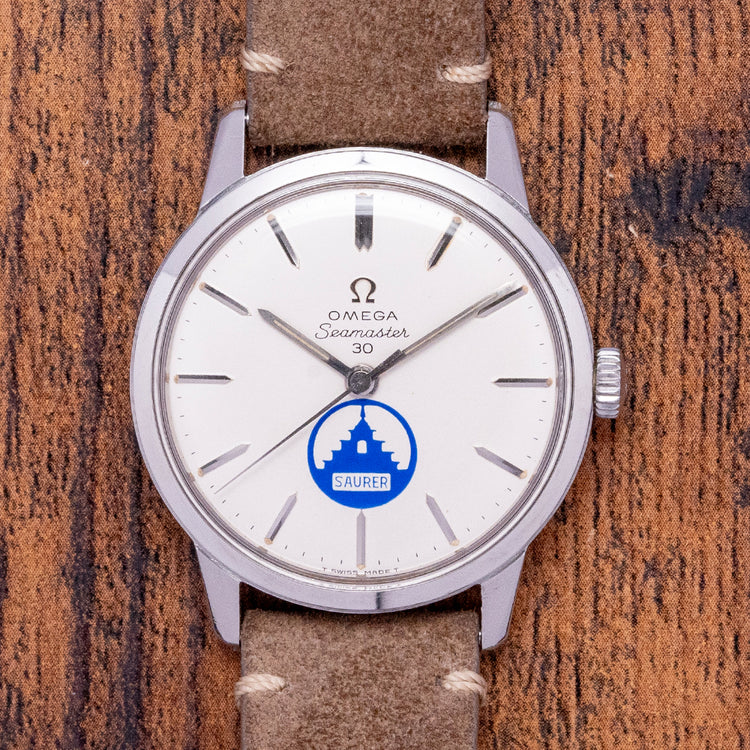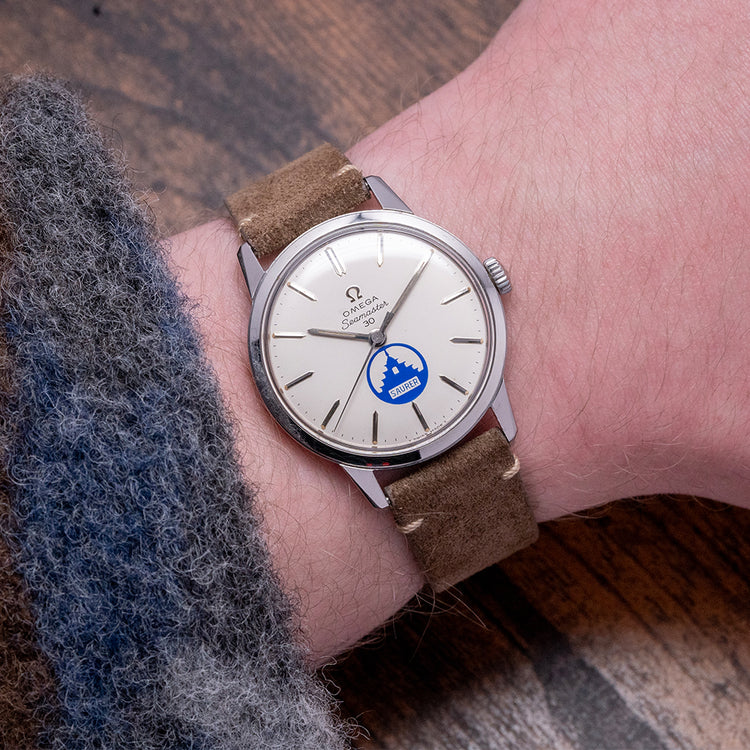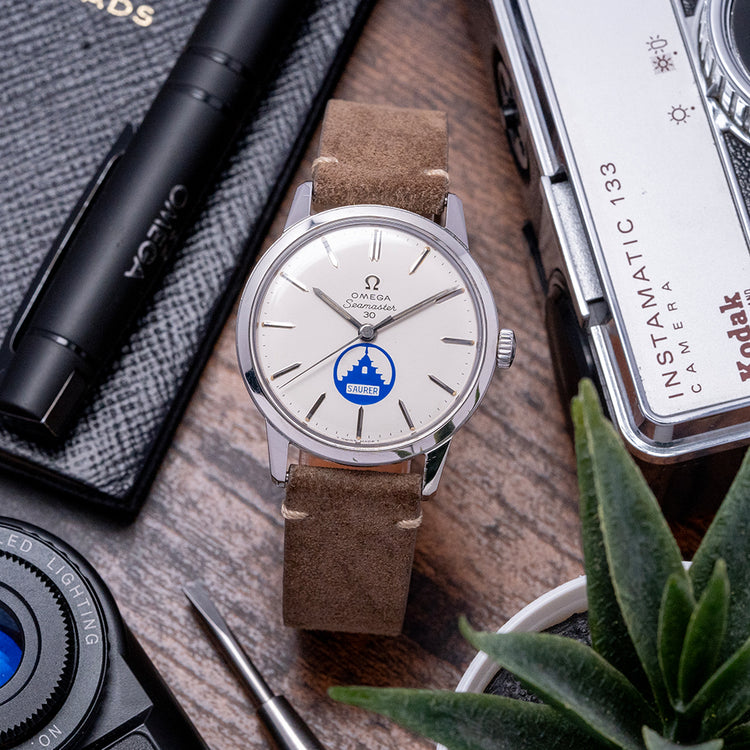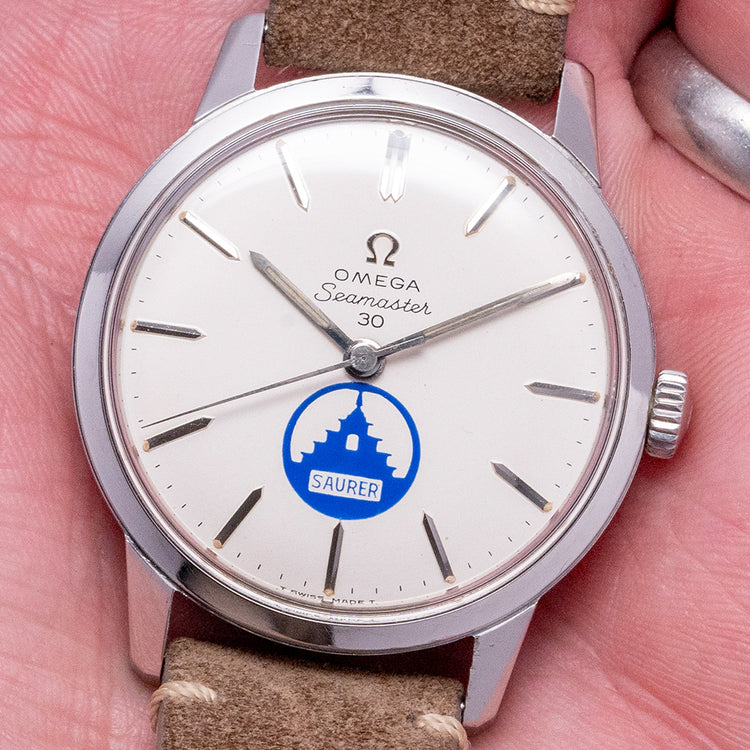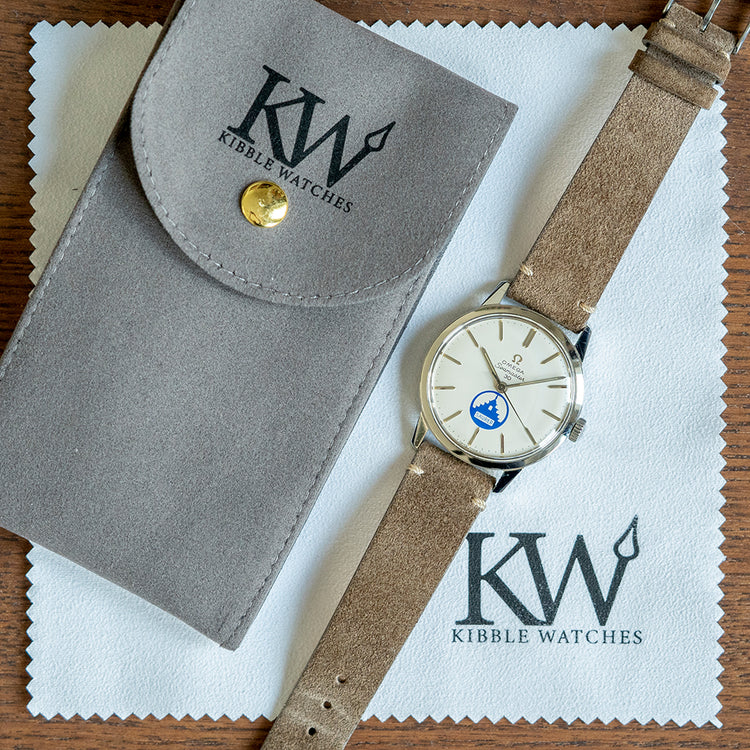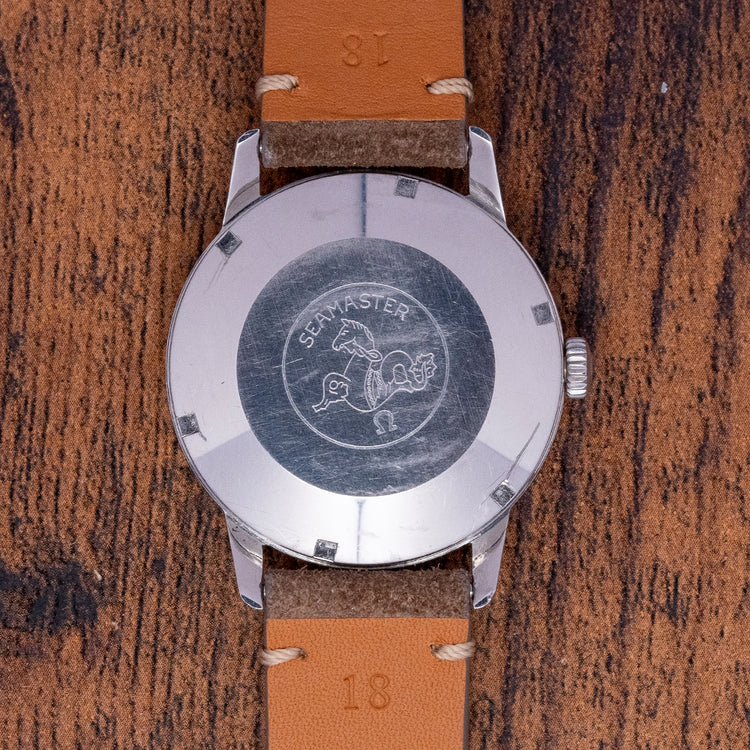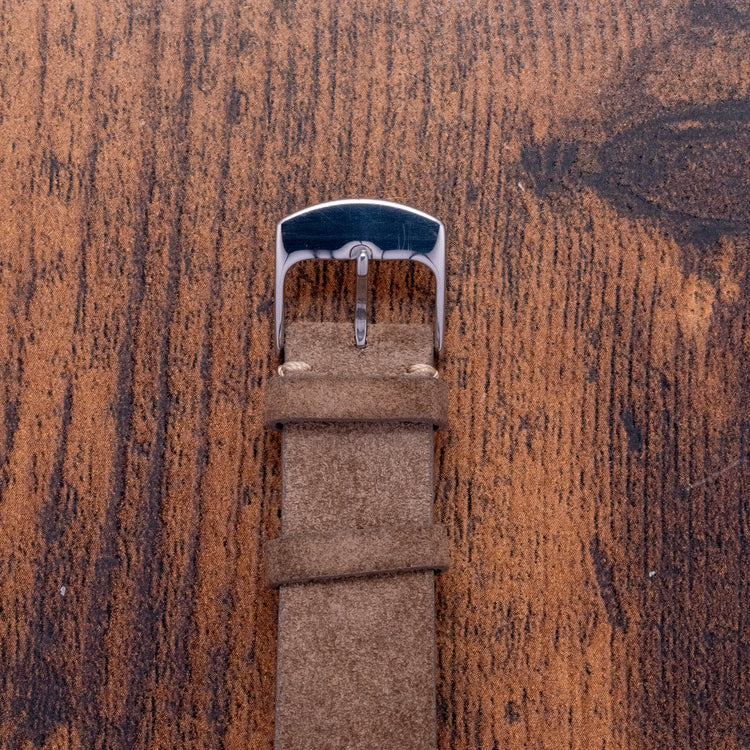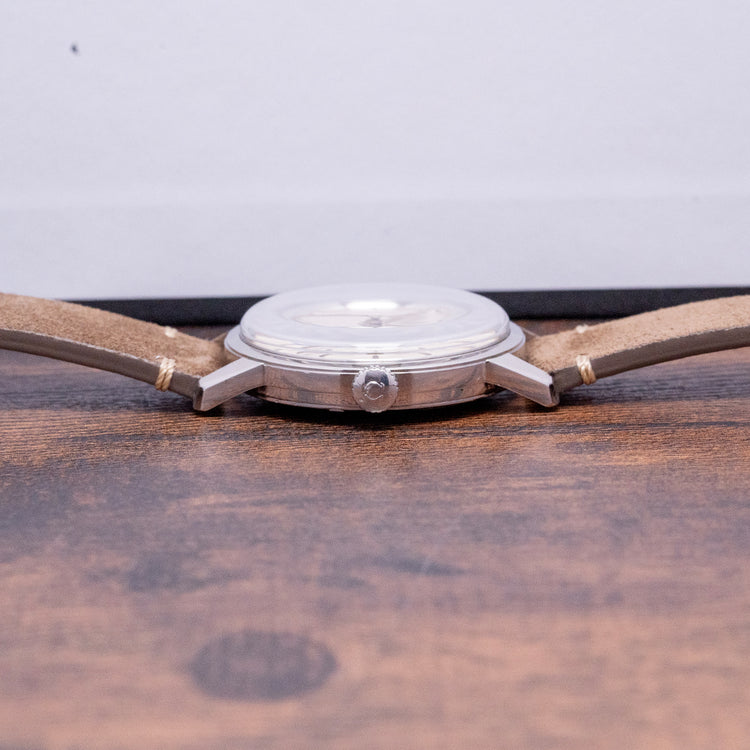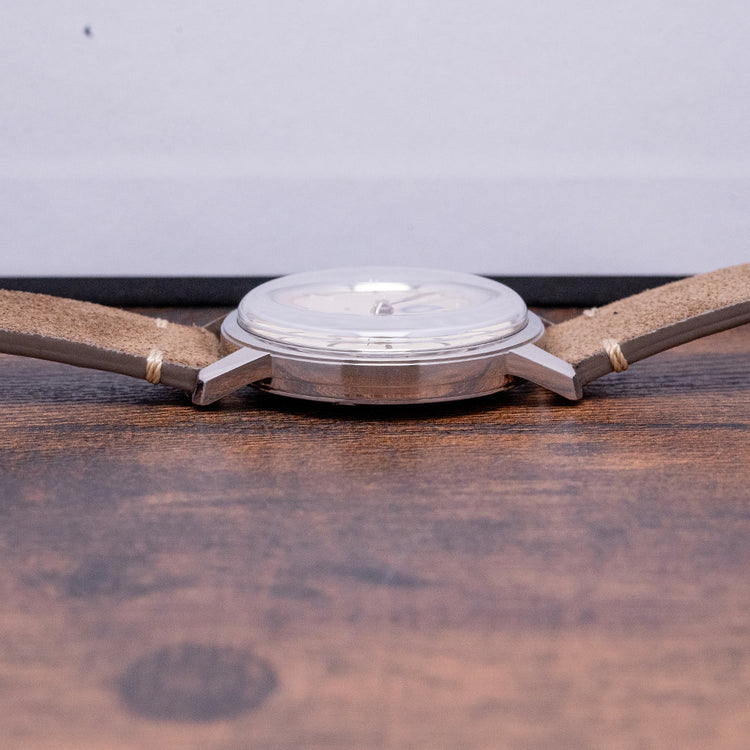More Information
Description
More
Less
The Watch
Here we have a rare 1963 Omega Seamaster 30 "Saurer Dial" 135.007 with a 35mm stainless steel case that curves over your wrist with thick tapered lugs, and a lug-to-lug length of 42mm and a case thickness of 10.5mm ensures a comfortable fit. On the right side is a signed crown and a smooth bezel holds a domed acrylic crystal above a white dual-branded dial. An outer minute track has Tritium pips and applied steel baton indexes marking the hours, slender baton hands tipped with Tritium are complemented by a tapered sweeping second hand, at 12 o’clock we have the applied Omega motif with “Seamaster 30” printed underneath and at 6 o’clock the blue Saurer logo, Adolph Saurer AG was a Swiss company that was founded in 1903 and remained active until 1982. The company was headquartered in Arbon, Switzerland, and was renowned for manufacturing various products, including embroidery and textile machines, as well as trucks and buses under the Saurer and Berna brand names. On the reverse a screw-down case back with the Omega Hippocampus engraved in the centre, a seahorse that represents Neptune the God of the sea, it was conceived by Pierre Borie after seeing a picture of Neptune riding a chariot pulled by seahorses, it is the reason why the seahorses are wearing a bridle, first seen on the Seamaster in 1958. Inside a manually wound Omega Cal. 286, 17 jewels, beat at a leisurely 18,000 beats per hour. The watch comes paired with a well-suited 18mm aftermarket strap and pin buckle.
Points of Mention
This watch is sold as "Watch only" and therefore comes with no original Omega box or paperwork. The watch comes paired with a well-suited 18mm aftermarket suede strap and pin buckle. The watch is from Circa. 1963 and is sold in worn, vintage condition, wear can be seen throughout the watch, but overall this is a fantastic example of this rare reference. The watch comes with our 12-Months NON-Waterproof Warranty.
For more photos see here - https://drive.google.com/drive/folders/16EV5pr_PApaQewW2X2ziAMY8HN19f7e3?usp=drive_link
4K YouTube video, skip to 16:23 - https://youtu.be/YMhgxLhvTfQ
Personal Note
If this Omega Seamaster 30 didn't have the "Saurer" logo on the dial it would still be one of the nicest examples I have had in stock, the addition of that logo only adds to how special this reference 135.007 from 1963 is! Saurer was a company based in Switzerland that manufactured all sorts from embroidery machines to trucks. It is safe to assume this was commissioned by them for their staff, likely reserved for the big bosses or best performers. I would not hesitate to add this gem to your collection, finding another will be tough, especially in this condition and at this price.
Specification
Lugs : 18mm
Condition : Pre-Owned
Box & Papers : None
Case Material : Stainless Steel
Warranty : 12-Months NON-Waterproof Warranty
The Brand
They were formerly known as the La Generale Watch Co. in 1848 founded by Louis Brandt in La Chaux-de-Fonds. When he died in 1879, his sons carried on his dream. In 1880 they moved to 96 Rue Jakob-Stampfli where they remain today. The brothers produced their first mass-produced calibre, the Labrador In 1885. Just a few years later in 1892, they produced the first minute-repeater. In 1903 they renamed the company Omega until 1982 when they officially changed their name to Omega SA. During WW1 Omega watches were used as official timekeepers for the Royal Flying Corps and the US Army. In 1930, Omega and Tissot merged together to form Société Suisse pour l'Industrie Horlogère (SSIH) In 1931, another group was formed - Allgemeine Schweizerische Uhrenindustrie AG (ASUAG). Where SSIH was primarily French-speaking, ASUAG was founded by the more German-speaking members of the Swiss watch industry. In 1948 they introduced the first edition of one of its most symbolic watches: the Seamaster. Omega first introduced the Constellation in 1952. At the time it was Omega's flagship timepiece. The first models had a Cal. 354 bumper movement in them. Later in 1955, Omega introduced the Automatic Cal. 50x, followed in 1959 by the Cal.55x (no date) and 56x (date) versions. Many of the Constellations came with pie-pan dials, diamond indexes, and fancy lug configurations. All the gold Constellations of that time have the Observatory of Geneva's hand engraved on the back. The stainless steel and stainless steel/gold versions had a gold medallion on the back with the Observatory of Geneva. The eight stars above the Observatory stand for the many exploits of Omega in the world Chronometer competition. Celebrating the fact that all Constellations are Chronometer Certified. In 1962, when astronaut Wally Schirra wore a Speedmaster on his Mercury Sigma 7 Mission, making it the first Omega watch to enter space. After rigorous tests, NASA used Omega for all their Apollo missions including the 1969 Moon landing of Apollo 11. Today Omega is still an astronaut's first choice. In 1969, President Nixon famously said it was “too valuable” and turned down the first-ever all-gold Speedmaster Professional Deluxe. As a response to the ever-growing threat of electronic watches to the manufacturers of mechanical watches, Omega and many Swiss brands such as Rolex and Patek Philippe formed Centre Electronique Horologer (CEH). Prototypes began to appear in 1967 with their production starting in 1968. Then In 1972, Omega introduced the reference, 198.030, which included the Omega calibre 1250, a ‘tuning-fork electronic movement which was made under licence from Bulova. Later we saw a merger of SSIH and ASUAG into SMH, or Société de Microélectronique et d’Horlogerie. This merger took place in 1983. In 1992, the company acquired Blancpain, and in 1998 it officially rebranded itself from SMH to the Swatch Group. Then, in 1999, they purchased and integrated Breguet into the Swatch Group.
Points of Mention
More
Less
Personal Note
More
Less
Specification
More
Less
Movement : Manually Wound Omega Cal. 286
Year : 1963
Case Size : 35mm
Case Thickness : 10.5 mm
Lug to Lug : 42mm
Lugs : 18mm
Condition : Pre-Owned
Box and Papers : None
Case Material : Stainless Steel
Warranty : 12-Months NON-Waterproof Warranty
The wrist model's wrist size is 7inch
About Omega
More
Less
Description
The Watch
Here we have a rare 1963 Omega Seamaster 30 "Saurer Dial" 135.007 with a 35mm stainless steel case that curves over your wrist with thick tapered lugs, and a lug-to-lug length of 42mm and a case thickness of 10.5mm ensures a comfortable fit. On the right side is a signed crown and a smooth bezel holds a domed acrylic crystal above a white dual-branded dial. An outer minute track has Tritium pips and applied steel baton indexes marking the hours, slender baton hands tipped with Tritium are complemented by a tapered sweeping second hand, at 12 o’clock we have the applied Omega motif with “Seamaster 30” printed underneath and at 6 o’clock the blue Saurer logo, Adolph Saurer AG was a Swiss company that was founded in 1903 and remained active until 1982. The company was headquartered in Arbon, Switzerland, and was renowned for manufacturing various products, including embroidery and textile machines, as well as trucks and buses under the Saurer and Berna brand names. On the reverse a screw-down case back with the Omega Hippocampus engraved in the centre, a seahorse that represents Neptune the God of the sea, it was conceived by Pierre Borie after seeing a picture of Neptune riding a chariot pulled by seahorses, it is the reason why the seahorses are wearing a bridle, first seen on the Seamaster in 1958. Inside a manually wound Omega Cal. 286, 17 jewels, beat at a leisurely 18,000 beats per hour. The watch comes paired with a well-suited 18mm aftermarket strap and pin buckle.
Points of Mention
This watch is sold as "Watch only" and therefore comes with no original Omega box or paperwork. The watch comes paired with a well-suited 18mm aftermarket suede strap and pin buckle. The watch is from Circa. 1963 and is sold in worn, vintage condition, wear can be seen throughout the watch, but overall this is a fantastic example of this rare reference. The watch comes with our 12-Months NON-Waterproof Warranty.
For more photos see here - https://drive.google.com/drive/folders/16EV5pr_PApaQewW2X2ziAMY8HN19f7e3?usp=drive_link
4K YouTube video, skip to 16:23 - https://youtu.be/YMhgxLhvTfQ
Personal Note
If this Omega Seamaster 30 didn't have the "Saurer" logo on the dial it would still be one of the nicest examples I have had in stock, the addition of that logo only adds to how special this reference 135.007 from 1963 is! Saurer was a company based in Switzerland that manufactured all sorts from embroidery machines to trucks. It is safe to assume this was commissioned by them for their staff, likely reserved for the big bosses or best performers. I would not hesitate to add this gem to your collection, finding another will be tough, especially in this condition and at this price.
Specification
Lugs : 18mm
Condition : Pre-Owned
Box & Papers : None
Case Material : Stainless Steel
Warranty : 12-Months NON-Waterproof Warranty
The Brand
They were formerly known as the La Generale Watch Co. in 1848 founded by Louis Brandt in La Chaux-de-Fonds. When he died in 1879, his sons carried on his dream. In 1880 they moved to 96 Rue Jakob-Stampfli where they remain today. The brothers produced their first mass-produced calibre, the Labrador In 1885. Just a few years later in 1892, they produced the first minute-repeater. In 1903 they renamed the company Omega until 1982 when they officially changed their name to Omega SA. During WW1 Omega watches were used as official timekeepers for the Royal Flying Corps and the US Army. In 1930, Omega and Tissot merged together to form Société Suisse pour l'Industrie Horlogère (SSIH) In 1931, another group was formed - Allgemeine Schweizerische Uhrenindustrie AG (ASUAG). Where SSIH was primarily French-speaking, ASUAG was founded by the more German-speaking members of the Swiss watch industry. In 1948 they introduced the first edition of one of its most symbolic watches: the Seamaster. Omega first introduced the Constellation in 1952. At the time it was Omega's flagship timepiece. The first models had a Cal. 354 bumper movement in them. Later in 1955, Omega introduced the Automatic Cal. 50x, followed in 1959 by the Cal.55x (no date) and 56x (date) versions. Many of the Constellations came with pie-pan dials, diamond indexes, and fancy lug configurations. All the gold Constellations of that time have the Observatory of Geneva's hand engraved on the back. The stainless steel and stainless steel/gold versions had a gold medallion on the back with the Observatory of Geneva. The eight stars above the Observatory stand for the many exploits of Omega in the world Chronometer competition. Celebrating the fact that all Constellations are Chronometer Certified. In 1962, when astronaut Wally Schirra wore a Speedmaster on his Mercury Sigma 7 Mission, making it the first Omega watch to enter space. After rigorous tests, NASA used Omega for all their Apollo missions including the 1969 Moon landing of Apollo 11. Today Omega is still an astronaut's first choice. In 1969, President Nixon famously said it was “too valuable” and turned down the first-ever all-gold Speedmaster Professional Deluxe. As a response to the ever-growing threat of electronic watches to the manufacturers of mechanical watches, Omega and many Swiss brands such as Rolex and Patek Philippe formed Centre Electronique Horologer (CEH). Prototypes began to appear in 1967 with their production starting in 1968. Then In 1972, Omega introduced the reference, 198.030, which included the Omega calibre 1250, a ‘tuning-fork electronic movement which was made under licence from Bulova. Later we saw a merger of SSIH and ASUAG into SMH, or Société de Microélectronique et d’Horlogerie. This merger took place in 1983. In 1992, the company acquired Blancpain, and in 1998 it officially rebranded itself from SMH to the Swatch Group. Then, in 1999, they purchased and integrated Breguet into the Swatch Group.
Points of Mention
Personal Note
Specification
The Brand
Enquire or Book an Appointment
Would you like to discover further details about this watch, or perhaps arrange an appointment to view and try it on? Complete this form and a member of our team will get back to you shortly.
You May Also Like




















